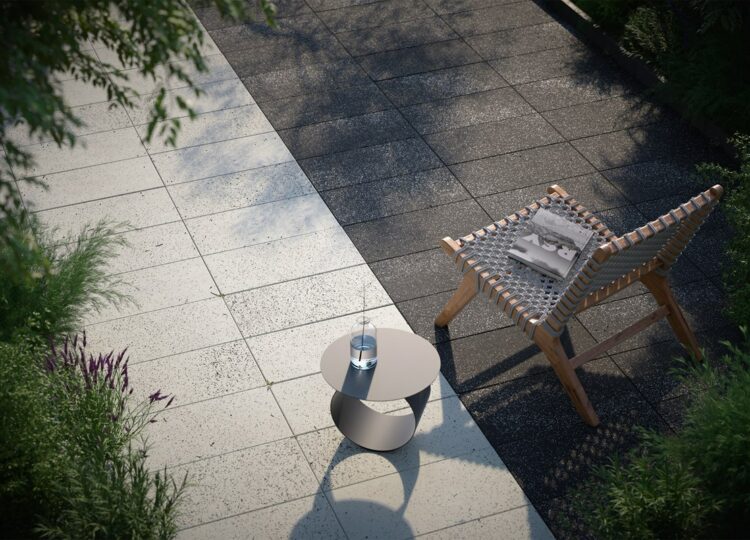
To understand the most significant differences between standard and noble surfaces, it is necessary to refer to the manufacturing process itself. The times when paving stones and slabs were made with a concrete mixer and human hands are long gone. Today, concrete products are created with the help of machines based on specialized formulas, using a variety of raw materials. In contrast to standard products, BRUK noble products are subject to specialized treatment and coloring methods that affect their high aesthetic and usable values, durability and functionality.
| TYPES OF BRUK SURFACES – COMPARISON | ||
| Standard surface | Noble surface | |
| High durability and functionality | yes | yes |
| Treatments improving aesthetic and functional values: | no | yes: depending on the surface type:
|
| Special raw materials, including noble ones | no | yes: depending on the surface type: white cement, inorganic pigments, high-grade aggregates. |
| Number of surface types: | 1 type:
|
several types:
|
| Colors | A few basic ones: graphite, gray and red. | Dozens: depending on the surface type |

For an even better understanding of what characterizes each noble surface, it is useful to read an in-depth description of each of them:
| TYPES OF NOBLE SURFACES OVERVIEW | |||||
| Surface type | TRIKOLOR: a three-color palette of color melanges | MULTIKOLOR: a multi-color palette of color melanges. | CALLISTO: rough and exclusive surfaces | TECHNO: single color surface | GALAXY: a topcoat motif resembling irregularly scattered aggregate |
| Special processing method | yes: specialized dyeing method | yes: specialized dyeing method | yes: specialized washing method | yes: specialized dyeing method | yes: specialized method of applying the top layer |
| Raw materials | Careful selection of raw materials, organic dyes and white cement. | Careful selection of raw materials, organic dyes and white cement. | The use of high-grade aggregates. | Careful selection of raw materials, organic dyes and white cement. | Careful selection of raw materials, organic dyes and white cement |
| Number of colors | 3 | 8 | 7 | 4 | 2 |
| Impregnation | Bulk hydrophobic treatment (BPQ) | Bulk hydrophobic treatment (BPQ) | Bulk hydrophobic treatment (BPQ); surface impregnation | Bulk hydrophobic treatment (BPQ); surface impregnation | Bulk hydrophobic treatment (BPQ); surface impregnation |
| Technologies used | BCQ, BPQ, BEQ | BCQ, BPQ, BEQ | BPQ, BEQ | BCQ, BPQ, BEQ | BCQ, BPQ, BEQ |
| Additional features | yes: increased slip resistance | ||||
| Awards | Highest Quality International 2021 Golden Emblem in the category QI Product – the highest quality product. | ||||
| Available patterns: | paving stone: Nova’k, Metro, Metro XL, Wena, | paving stones: Mandal, Nova’k, Vjetra®, Metro, Metro XL, Wena, Grand, Bruk Simple, Fantazja, Trend, Mosaic. | paving stones: Wena, Bruk Simple, Grand, Fantasy. | paving stones: Mandal, Vjetra®, Metro, Metro XL, Bruk Simple, Grand, | paving stones: Metro, Metro XL, |
| slabs:Bruk’us, Kwadra, Medio, Magnum, Multi, Solid, ecoSolid. | slabs: Simple | slabs: Geometrika, Kwadra, Medio, Flat, Magnum, Multi, Solid, Style, ecoSolid, Simple. | slabs: Kwadra, Medio, Magnum, Simple, Solid. | ||

A very important feature of Bruk noble surfaces is the use of original technologies in the production process, called Bruk Color Quality and Bruk Protect Quality. Depending on the type of surface, the systems can be used together or separately:
| ORIGINAL TECHNOLOGIES OF NOBLE SURFACES | ||
| Bruk Color Quality (BCQ) is a technology mainly based on the careful selection of raw materials and the use of white cement and inorganic dyes. Thanks to this, the products are given intense and long-lasting colors | Bruk Protect Quality (BPQ) is an impregnation system improving the stones resistance to moisture and dirt, facilitating cleaning, protecting the surface against penetration of rainwater, thanks to which the paving stones do not crack, do not peel in freezing temperatures and the formation of lime deposit is hindered. | Bruk Eco Quality (BEQ) is an innovative formula based primarily on the optimization of the production process and the use of raw materials reducing the carbon footprint of concrete, and thus reducing carbon dioxide emissions into the atmosphere. |
